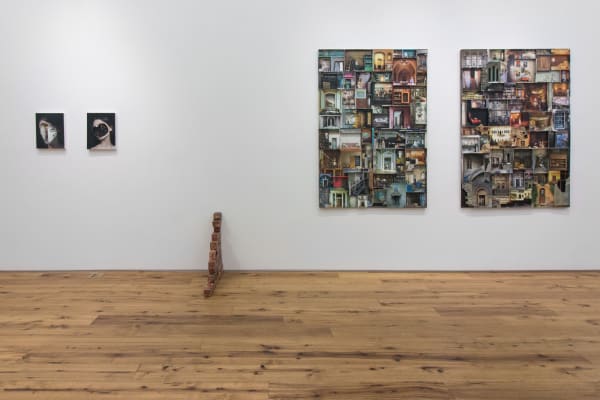Chris Jones
NEW YORK – The gallery presents its third solo exhibition of British artist Chris Jones, featuring new works made almost entirely of appropriated printed material.
Chris Jones’ London studio is covered in images culled from discount books and discarded magazines. He is interested in their protean power to unlock subconscious associations and serendipitous connections. When developing a work, Jones refrains from looming obvious narrative threads − instead his wondrous constructions invite interpretations based on the viewer’s personal memories and perspectives.
The Apartment series are wall-mounted diagrammatic tableaux where different timelines, geographies and cultures co-exist within an imagined residential apartment. Jones exposes rooms that at times have visual synchronicity and elsewhere are completely incongruous with one another. Motifs such as vein-like pipe systems span several rooms while clothes may spill out from one and invade another – each Apartment is a phenomenological puzzle.
For the first time Jones’ Apartments have evolved into a grand freestanding tower sculpture. All four sides of the building interact; peer into a room and see across to details from another. Piranesi stairs lead to visual dead-ends whilst suggesting further hidden rooms; architectural facades from all cultures characterize the exterior walls. Here is an anachronistic Tower of Babel or a J.G. Ballardian High Rise captured in three dimensions.
A recurring theme is the high-speed vehicle such as the sports car and motorcycle. Jones sculpts a mimetic version but also allows alternate worlds to form within the object. In the show, a fiery red racing bike is left abandoned – once a symbol of speed and thrills, its current entropic state harbors new life within its cavernous shell, recalling Thomas Coles’ evolutionary cycles.
In a sense, Jones’ work is less an act of sculpture and more of subverting existing forms – the various reproductions of fruits in a nearby still life are created through a tautological process of layering papier-mache images over actual fruits. Within Jones’ version of this 17th-century Vanitas, a Memento Mori human skull reveals a grand cathedral dome on verso; the ruins of an amalgamated historic building emerge through the composition, together they create an allegorical enigma.
Finally, the gallery space itself becomes an experiential image. In this mid-19th century former tenement building Jones has suggested traces of vanished rooms with bricks and collapsed walls. The visitor navigates these spaces to discover artworks within and thus experiences Jones’ illusionary world, both enchanting and metaphysical.







